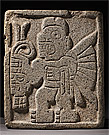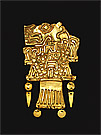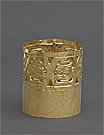Exhibition themes Early cultures-Chavín,Cupisnique,Pacopampa,Virú-Gallinazo
Early northern cultures developed sophisticated techniques of carving, metalworking and ceramics. Transformational figures of animals and gods were carved into the walls and underground rooms of temples, hammered into metal and formed from clay. Strong and powerful hunters—snakes, jaguars, caiman and harpy eagles—are the creatures depicted in composite figures, as humans became gods.
Chavín was probably a religious cult, which flourished in the highlands. It was centred on the large ritual complex of Chavín de Huántar. Beginning before 1500 BC, the Chavín style spread over much of north and central Peru, even as far as the Paracas Peninsula on the south coast. It continued for more than 1,000 years.
These societies show no evidence of systematic irrigation, unlike in the drier south. Although hunting and fishing provided meat, most food came from agriculture. Ceramics and stone carvings have been found in the ceremonial centre at Pacopampa. Artefacts made by the Cupisnique reveal belief in a jaguar cult. Personal adornment was important, especially carved or inlaid shell and semi-precious stones. After the as yet unexplained disintegration of the Chavín civilisation, many populated valleys previously under its religious sway produced objects in their own styles, for example the patterned ceramics of Virú.










